|
 Weraroa novae-zelandiae Weraroa novae-zelandiae
SynonymsSecotium novae-zelandiae
BiostatusPresent in region - Indigenous. Endemic
Images (click to enlarge)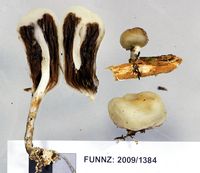
Owner: J.A. Cooper | 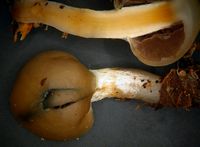
Owner: J.A. Cooper | 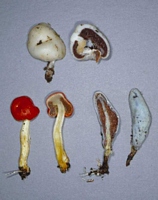
Caption: Weraroa novaezelandiae (top), W. erythrocephala (left), and W. virescens (right).
Owner: R.E. Beever | 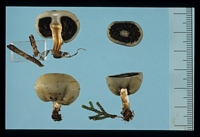
Caption: 15/07/84 REB348
Owner: Ross Beever | 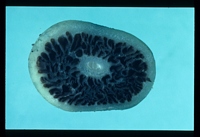
Caption: REB348, MARC 840715, 15/07/84
Owner: Ross Beever |
Article: Cunningham, G.H. (1924). A critical revision of the Australian and New Zealand species of the genus Secotium. Proceedings of the Linnean Society of New South Wales 49(2): 97-119.
Description: Peridium commonly french-grey, changing in old specimens to pallid-green, ovate or elliptic-oblong,
apex bluntly acuminate or obtuse, base bluntly rounded, or decurrent, 3-5 cm. high,
1.5-3 cm. wide, at first finely fibrillose, fibrils longitudinally arranged, so that the surface
appears striate, becoming smooth, glabrous, polished and slightly viscid, coriaceous; margin
folded and frequently lacerate, drying dingy brown. Stipe pallid french-grey or tinted bluish-green,
yellowish at the base, slender, up to 4 cm. long, and 6 mm. thick, equal, at first
fibrillose, becoming glabrous and polished, save at the base,. hollow; columella thickened at
the apex. Gleba chocolate- or sepia-brown, coarsely cellular, sometimes lamellar, cells
elongated, up to 10 mm., sparse, laterally compressed, dissepiments thin. Spores smooth,
sepia-coloured, elliptic-ovate or elliptical, rounded at one end, 11-15 x 5-8 µ, epispore thin.
Habitat: Habitat.-Solitary or crowded on decaying wood buried in the substratum. In lowland rain
forest.
Notes: The sepia colour of the gleba serves to separate this from any other species in this section. It is
fairly abundant in the early winter and spring months in lowland mixed rain-forest near
Wellington. It occurs only on decaying wood, principally on rotting branches of Melicytus
ramiflorus Forst. I have recently obtained a very complete suite of developmental stages, from
which the abbreviated account of its development has been drawn up. The plant is usually covered
with dried leaves, and so difficult to find unless these be first removed. It is readily eaten by slugs,
and it is in consequence often difficult to find mature specimens that have not been injured by
these animals.
The shape of the peridium varies considerably in different specimens, for one may obtain
ovate, elliptical or even depressed-globose plants. When the plant is ovate, the columella is
usually considerably thickened at the apex. Another variable feature is the gleba, which may
in certain specimens be cellular, whilst in others it may be lamellas, approaching in extreme
cases the gleba of 3. agaricoides. As all intermediate stages may be collected it is impossible
to segregate these forms, save at the extremes.
|